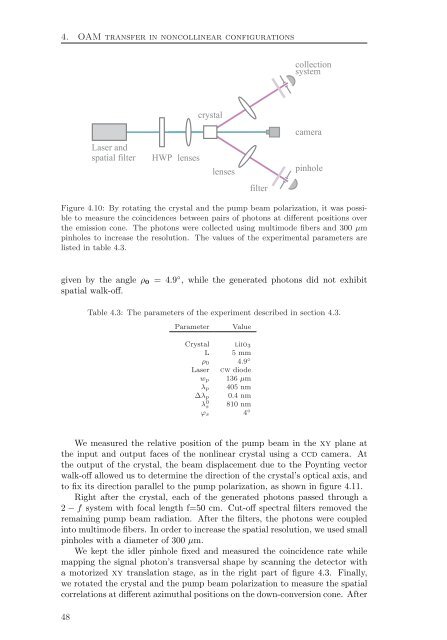Spatial Characterization Of Two-Photon States - GAP-Optique
Spatial Characterization Of Two-Photon States - GAP-Optique
Spatial Characterization Of Two-Photon States - GAP-Optique
Create successful ePaper yourself
Turn your PDF publications into a flip-book with our unique Google optimized e-Paper software.
4. OAM transfer in noncollinear configurations<br />
Laser and<br />
spatial filter HWP lenses<br />
crystal<br />
lenses<br />
filter<br />
collection<br />
system<br />
camera<br />
pinhole<br />
Figure 4.10: By rotating the crystal and the pump beam polarization, it was possible<br />
to measure the coincidences between pairs of photons at different positions over<br />
the emission cone. The photons were collected using multimode fibers and 300 µm<br />
pinholes to increase the resolution. The values of the experimental parameters are<br />
listed in table 4.3.<br />
given by the angle ρ0 = 4.9 ◦ , while the generated photons did not exhibit<br />
spatial walk-off.<br />
Table 4.3: The parameters of the experiment described in section 4.3.<br />
Parameter Value<br />
Crystal liio3<br />
L 5 mm<br />
ρ0 4.9◦ Laser cw diode<br />
wp 136 µm<br />
λp 405 nm<br />
∆λp 0.4 nm<br />
λ0 s<br />
ϕs<br />
810 nm<br />
4◦ We measured the relative position of the pump beam in the xy plane at<br />
the input and output faces of the nonlinear crystal using a ccd camera. At<br />
the output of the crystal, the beam displacement due to the Poynting vector<br />
walk-off allowed us to determine the direction of the crystal’s optical axis, and<br />
to fix its direction parallel to the pump polarization, as shown in figure 4.11.<br />
Right after the crystal, each of the generated photons passed through a<br />
2 − f system with focal length f=50 cm. Cut-off spectral filters removed the<br />
remaining pump beam radiation. After the filters, the photons were coupled<br />
into multimode fibers. In order to increase the spatial resolution, we used small<br />
pinholes with a diameter of 300 µm.<br />
We kept the idler pinhole fixed and measured the coincidence rate while<br />
mapping the signal photon’s transversal shape by scanning the detector with<br />
a motorized xy translation stage, as in the right part of figure 4.3. Finally,<br />
we rotated the crystal and the pump beam polarization to measure the spatial<br />
correlations at different azimuthal positions on the down-conversion cone. After<br />
48



